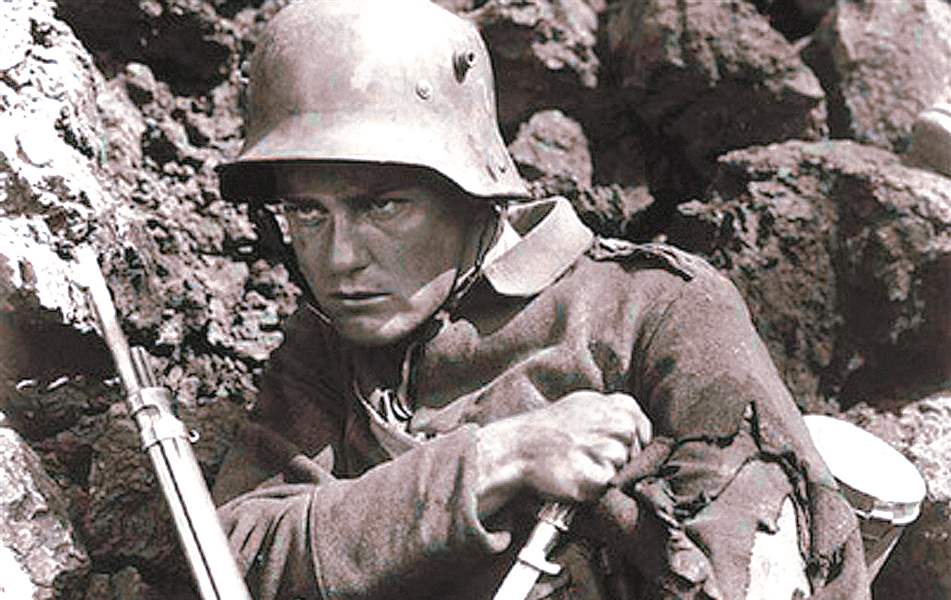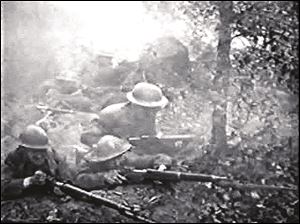
Hollywood tells the reel story of World War I, both horrific and heroic
7/13/2014
Lew Ayres starred in the film "All Quiet on the Western Front," based on the anti-war novel.

Lew Ayres starred in the film "All Quiet on the Western Front," based on the anti-war novel.
War is hell.
And by Hollywood standards, it’s also exceedingly complicated, particularly how we view World War I.
Almost a century removed from the official declaration of the global conflict -- July 28, 1914 -- the legacy of the “war to end wars” onscreen is a tug-of-war of conflicting ideas and moral certitudes, often mirroring prevailing audience judgment.
It’s a familiar pattern that begins sans post-war reflection and contemplation, amid the flag-waving revelry of a nation united in victory.
RELATED: 10 notable World War I movies
Burton L. King’s silent film The Lost Battalion is such a work. Released in 1919, The Lost Battalion chronicles a bloody behind-enemy-lines stand by troops of the U.S. Army's 77th Division against the Germans. The six-day battle took place in early October, 1918 -- about a month before the war ended and less than a year before Hollywood offered its own account of the story.

A still shot from the 1919 silent film, "The Lost Battalion," which featured several soldiers who survived the battle.
Featuring several of the surviving soldiers as themselves, The Lost Battalion is Hollywood‘s welcome home party thrown for the troops, who don’t always look comfortable at the feting -- especially when it involves reliving an excruciating wartime experience so fresh in their minds. Only three years after commanding the 77th Division, Lt. Col. Charles W. Whittlesey committed suicide at sea by jumping overboard a steamship; his body was never recovered.
For a nation desperate for normalcy and searching for meaning amid global destruction and death -- more than eight million soldiers worldwide died during WWI-- Hollywood was only too happy to offer assurances that our troops fought the good fight and that life was moving on quite well.
The latter message still resonated as powerful propaganda decades later with the release of Sergeant York in 1941.
Based on the autobiography of Alvin York, a decorated U.S. soldier from backwoods Tennessee credited with killing 28 German soldiers and capturing more than 130 others in a single charge against enemy forces in World War I, Sergeant York was released on Sept. 27, 1941 -- less than three months before Pearl Harbor.
The timing of the film’s release, of course, was suspect. As the New York Times film critic noted in his favorable review of Sergeant York: “At this time, when a great many people are thinking deep and sober thoughts about the possible involvement of our country in another deadly world war, Warner Brothers and a bewildering multiplicity of collaborative producers and writers have reflected propitiously upon the motives and influences which inspired America's No. 1 hero in the last war,” later noting, “The suggestion of deliberate propaganda is readily detected here.”
Promoting Red, White, and Blue proved to be exceptionally popular. Boxofficemojo.com estimates Sergeant York’s $16-million-plus haul to be worth more than $383 million in today’s dollars, placing it No. 105 all-time domestically -- only two slots ahead of 1986’s equally jingoistic Top Gun.
The popular war drama was directed by Howard Hawks, himself a WWI pilot who also helmed the classic 1930 anti-war film The Dawn Patrol, and stars Gary Cooper, who earned the first of his two Best Actor Oscars playing the title role, and like Hawks, had an anti-war film to his credit, starring in the 1932 adaptation of Ernest Hemingway’s A Farewell to Arms.
Cooper also had a small role in the 1927 masterpiece Wings, the first Academy Award for Best Picture winner. The story of two young American ace WWI pilots in love with the same woman, Wings is known for its breathtaking and dangerous aerial footage of biplanes chasing through the clouds in balletic dogfights and for Harry Perry’s stunning cinematography. The film takes neither a pro nor anti-war stance, rather the more universal message that war is hell and that bad things happen to good people.
But three years later and there was a sizable shift in the conventional wisdom of the Great War -- at least in Hollywood’s fickle terms -- with the stirring adaptation of All Quiet on the Western Front. Based on Erich Maria Remarque’s dark and cynical anti-war novel, All Quiet on the Western Front is the story of a group of young German students swept up in the WWI patriotic crusade to protect the Fatherland, who volunteer for the cause, only to learn that war isn’t the noble pursuit of heroes, but a series of inexorable horrors to survive: bullets, bombs, starvation, disease, and madness.
It’s a theme of bravery and heroism through daily survival, with naive soldiers demarcated as unwitting pawns in the fervency of nationalism.
Stanley Kubrick would take that anti-war message further -- castigating in particular those calling the shots behind the lines -- with 1957’s Paths of Glory, the story of French soldiers rebelling against their superior officers who task them with an impossible mission against a German stronghold in World War I. After their failure to follow the suicidal orders, three of the troops are selected for court martial, with their commanding officer Lt. Dax (Kirk Douglas) serving as their defense.
Based on Humphrey Cobb’s 1937 novel, Paths of Glory is blistering with contempt without being heavy-handed, a striking anti-war propaganda as persuasive as any pro-military call-to-arms.
But as bleak as its in-the-trenches warfare may be, it’s positively cheery when compared to Dalton Trumbo’s cult anti-war film Johnny Got His Gun.
The story of a WWI American soldier blown up, and kept alive by the military without arms, legs, and a face (including a tongue, eyes, ears, and nose) Johnny Got His Gun was first published in 1939 as an anti-war novel by Trumbo. Already a successful screenwriter, Trumbo would later script A Guy Named Joe (1943), Spartacus (1960), and Papillon (1973). But it was the height of the wildly unpopular Vietnam War that caused him to adapt his novel to the big screen in 1971, with Timothy Bottoms as the soldier named Joe who’s trapped in his body and unable to communicate with others. “I’m just like a piece of meat that keeps on living,” he says.
Even after Joe is finally able to breakthrough to those looking after him, by ingeniously banging his head on a pillow in Morse code, his request to be publicly displayed by the military as an anti-war curiosity is politely denied.
“All you have to do is put me on display and people will pay to see me,” Joe thinks. “Lots of people. Put me in a fancy coffin with windows in it, and take me out where people are spending money and having fun. ... Advertise me as the only piece of meat in the world that can talk through the back of its head. And if that doesn't pull them in, then ... then ... then ... then bill me as the last man on earth who joined the Army. Because the army makes men. So rally around the flag, boys -- your flag, their flag, anybody's flag -- because the flag needs soldiers, and the army makes men.”
Contact Kirk Baird at: kbaird@theblade.com or 419-724-6734.